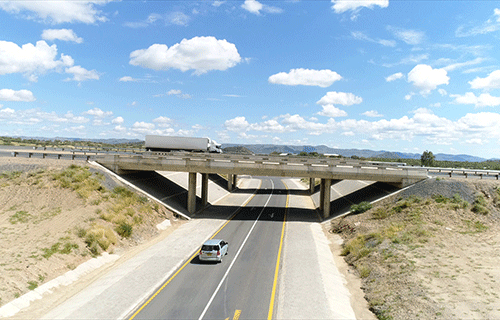The Roads Authority (RA) is a non-profit making public entity which was established in the year 2000 by virtue of the Roads Authority Act 17 of 1999 with the sole mandate to manage Namibia’s national road network with a view to achieve a safe and efficient road sector. The RA aligns its Strategic Plan, Key Performance Indicators (KPI) and Road Master Plan with the National Development Plan (NDP5) and Harambee Prosperity Plan, that confines to Namibia’s Vision 2030. It is through that alignment that RA ensures that projects and programmes are implemented according to national priority. The RA endeavours to strive to extend Namibia’s road network to all corners of the country by constructing safe and efficient roads.
“The authority is aware that proactive collaboration amongst decision-makers of all transport modalities is required to ensure that synergy is unlocked. It requires a collective focus on the transport and logistics needs of the Namibian nation, within the context of the National Development Agenda,” Conrad Lutombi, RA CEO said.
As Namibia celebrates 31 years of peace, democracy and prosperity, this again, according to the CEO, requires leadership from all modes of transport to come together and align strategies to ensure a sustainable transport sector to stimulate and sustain Namibia’s growth going forward.
Public-private partnership must be explored to continue to manage the country’s road network optimally in order to achieve a safe and efficient road sector in support of socio-economic growth.
“This requires collaborative efforts from all strategic stakeholders to ensure that no-one is left behind on the journey towards prosperity,” Lutombi emphasised.
“As we move into the future, we endeavour to strive to improve the condition of our national road network despite the financial constraints facing us. We will also continue to use technology to improve our efficiency within the organisation and with our stakeholders,” he added.
“I want to applaud the significant strides made by the RA’s leadership and teams at all levels in achieving the strategic imperatives over the last three decades. However, we will now pursue even more ambitious objectives and targets to ensure that we serve the needs of the road users and our stakeholders,” the CEO noted.
Since its inception, the RA has made significant strides in expanding Namibia’s road network in its efforts to achieve the national vision and goals for transport Infrastructure as set out in the National Development Plan and Namibia’s Vision 2030.
Currently the road network comprises 48 899.89 kilometres (km) of roads, of which 8 259.4 km is bitumen; 25 889.3 km gravel; 13 359.9 km earth roads; 189.3 km salt roads and 1 201.9 km proclaimed only roads. The road network grew from 41 815 km in 1990 to 48 899.89 km currently, an increase of 17%.
The country’s bitumen road network has since independence in 1990 increased from 4 572 km to 8 259.4 km which represents a growth of 73%. A noticeable number of gravel roads were also upgraded to bitumen standard, and thus the increase in the gravel road network appears to be minimal.
The gravel road network which was 25 550 km at independence is currently at 26 046.6 km an increase by 1.9%. Currently, about 53% of the road network is gravel while 17% is bitumen, and the CEO says that upgrading of the road network from gravel to bitumen standard has not been as fast as desired, mostly because of funding limitations.
However, comparing the current road network to that during independence, there has been significant progress, especially in upgrading roads to bitumen standard.
Lutombi noted that in order to ensure further development, the RA is busy with programmes to develop and expand the seven regional transport corridor routes that connect the country with neighbouring states through the port of Walvis Bay.
“In addition, the transport sector is busy establishing its logistic hub facilities that will amongst others include dry ports and storage facilities at Karibib, Grootfontein and Katima Mulilo to assist landlocked countries to reduce travelling time to the coastal towns.”
Furthermore, the construction of major projects such as the Hosea Kutako International Airport-Windhoek dual carriageway road project, will promote Namibia as a logistics hub by providing a link to the rail network and international airport infrastructure.
“The RA also aims to promote regional integration through regional development plans by implementing projects which connect regions. These projects include the upgrading of the MR91: Gobabis-Aminuis-Aranos road which connects the Omaheke and Hardap regions.”
Additionally, the organisation also implements programmes aimed at providing rural access by connecting communities to schools, clinics and community centres.
“We are currently also busy completing gravel roads in the Ohangwena region, which are part of the Rural Access Roads programme. This initiative will be extended to the Kavango East and West regions as well,” Lutombi adds.
One of RA’s contributions to society since its inception is the provision of on-the-job training to SMEs in the road construction industry, especially in the field of road maintenance and labour-based road construction. The authority always ensures that employment opportunities are created for Namibians on road construction and maintenance projects, which is in line with its SME Development Policy, which takes cognizance of the fact that creating employment is one of the major national development goals of Namibia.
“For bigger capital projects, the RA has advocated the awarding of road projects to joint ventures between well-established Namibian and international road contractor companies, primarily on the premise of skills transfer, capacity building and growing the Namibian road construction industry. These efforts will continue to benefit local contractors,” according to the CEO.
The RA has vowed to remain a focused, learning organisation that delivers on its mandate and aspires to achieve the targets set in its strategic plan, especially with regard to creating rural accessibility through the construction of access roads throughout the country.
One of the authority’s main focuses is to reach its target of improving service delivery at its Namibia Traffic Information System (NaTIS) centres to above 70% customer satisfaction.


